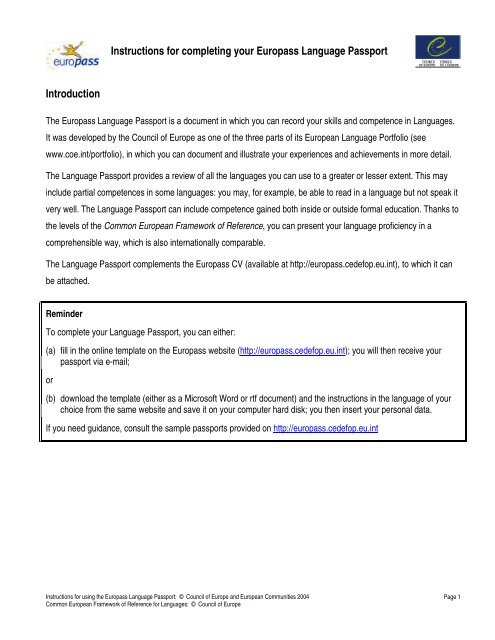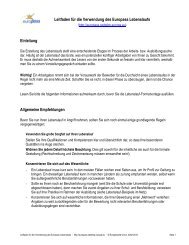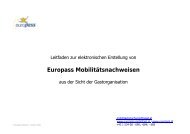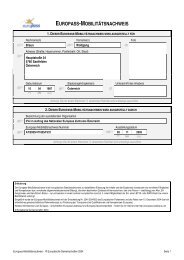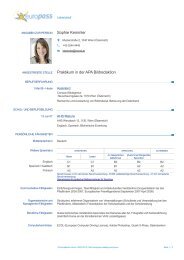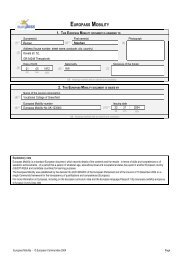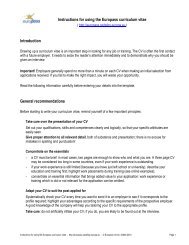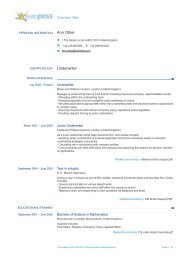Instructions for completing your Europass Language Passport ...
Instructions for completing your Europass Language Passport ...
Instructions for completing your Europass Language Passport ...
You also want an ePaper? Increase the reach of your titles
YUMPU automatically turns print PDFs into web optimized ePapers that Google loves.
<strong>Instructions</strong> <strong>for</strong> <strong>completing</strong> <strong>your</strong> <strong>Europass</strong> <strong>Language</strong> <strong>Passport</strong><br />
Introduction<br />
The <strong>Europass</strong> <strong>Language</strong> <strong>Passport</strong> is a document in which you can record <strong>your</strong> skills and competence in <strong>Language</strong>s.<br />
It was developed by the Council of Europe as one of the three parts of its European <strong>Language</strong> Portfolio (see<br />
www.coe.int/portfolio), in which you can document and illustrate <strong>your</strong> experiences and achievements in more detail.<br />
The <strong>Language</strong> <strong>Passport</strong> provides a review of all the languages you can use to a greater or lesser extent. This may<br />
include partial competences in some languages: you may, <strong>for</strong> example, be able to read in a language but not speak it<br />
very well. The <strong>Language</strong> <strong>Passport</strong> can include competence gained both inside or outside <strong>for</strong>mal education. Thanks to<br />
the levels of the Common European Framework of Reference, you can present <strong>your</strong> language proficiency in a<br />
comprehensible way, which is also internationally comparable.<br />
The <strong>Language</strong> <strong>Passport</strong> complements the <strong>Europass</strong> CV (available at http://europass.cedefop.eu.int), to which it can<br />
be attached.<br />
Reminder<br />
To complete <strong>your</strong> <strong>Language</strong> <strong>Passport</strong>, you can either:<br />
(a) fill in the online template on the <strong>Europass</strong> website (http://europass.cedefop.eu.int); you will then receive <strong>your</strong><br />
passport via e-mail;<br />
or<br />
(b) download the template (either as a Microsoft Word or rtf document) and the instructions in the language of <strong>your</strong><br />
choice from the same website and save it on <strong>your</strong> computer hard disk; you then insert <strong>your</strong> personal data.<br />
If you need guidance, consult the sample passports provided on http://europass.cedefop.eu.int<br />
<strong>Instructions</strong> <strong>for</strong> using the <strong>Europass</strong> <strong>Language</strong> <strong>Passport</strong>: © Council of Europe and European Communities 2004<br />
Common European Framework of Reference <strong>for</strong> <strong>Language</strong>s: © Council of Europe<br />
Page 1
Detailed instructions <strong>for</strong> filling in the <strong>Europass</strong> <strong>Language</strong> <strong>Passport</strong><br />
General recommendations<br />
Be<strong>for</strong>e starting to fill in <strong>your</strong> <strong>Language</strong> <strong>Passport</strong>, remember a few important principles:<br />
I. Keep to the structure of the template<br />
The <strong>Language</strong> <strong>Passport</strong> allows you to present <strong>your</strong> language competences and qualifications in a logical order:<br />
1. personal in<strong>for</strong>mation;<br />
2. <strong>for</strong> every relevant language:<br />
(a) a description of <strong>your</strong> skills based on self-assessment;<br />
(b) <strong>your</strong> diploma(s) and certificate(s);<br />
(c) relevant examples of <strong>your</strong> experience of the language and its culture.<br />
NB:<br />
- Print <strong>your</strong> <strong>Language</strong> <strong>Passport</strong> on white paper;<br />
- Retain the suggested font and layout;<br />
- Avoid underlining or writing whole sentences in capitals or bold: it affects the readability of the document;<br />
- Do not change the wording of the left-hand column<br />
- Remove any heading left blank.<br />
II. Be clear and concise<br />
An impression of <strong>your</strong> profile should be gained after just a few seconds’ reading. You should there<strong>for</strong>e:<br />
- be brief, and<br />
- include only relevant elements of <strong>your</strong> education and experience.<br />
Be realistic in <strong>your</strong> self-assessment. Any overestimation of skills is likely to be revealed during an interview or <strong>your</strong><br />
probationary period.<br />
III. Check <strong>your</strong> <strong>Language</strong> <strong>Passport</strong> on completion<br />
Check <strong>your</strong> <strong>Language</strong> <strong>Passport</strong> carefully once completed to remove any spelling mistakes and make sure it is<br />
<strong>for</strong>mulated clearly and logically.<br />
Have someone else read it to be sure the content is clear and easy to understand.<br />
<strong>Instructions</strong> <strong>for</strong> using the <strong>Europass</strong> <strong>Language</strong> <strong>Passport</strong>: © Council of Europe and European Communities 2004<br />
Common European Framework of Reference <strong>for</strong> <strong>Language</strong>s: © Council of Europe<br />
Page 2
<strong>Europass</strong> <strong>Language</strong> <strong>Passport</strong><br />
Part of the European <strong>Language</strong> Portfolio developed by the Council of Europe<br />
Surname(s) and first name(s) of the holder<br />
Enter <strong>your</strong> surname(s) and first name(s), e.g.:<br />
Surname(s) First name(s)<br />
Lonsdale, Stephen<br />
Date of birth (optional)<br />
Enter date of birth (dd/mm/yyyy), e.g.:<br />
Date of birth (*) 08/12/1971<br />
Mother tongue(s)<br />
Specify mother tongue(s), e.g.:<br />
Mother tongue(s)<br />
English<br />
NB: If you grew up with more than one language and feel you are equally proficient in all of them, list them all as mother<br />
tongues.<br />
Other language(s)<br />
List the other languages in which you have acquired some competence, e.g.:<br />
Other language(s)<br />
Spanish, French, Czech<br />
NB:<br />
- It is up to you which language you place first. If you are applying <strong>for</strong> a job that specifically requests skills in, <strong>for</strong> example,<br />
Czech, you may choose to put this language first, even if it is not <strong>your</strong> strongest language. In other cases you will probably<br />
choose to list <strong>your</strong> best languages first.<br />
- For every language, complete the relevant headings (<strong>Language</strong>, Self-assessment of language skills, Certificate(s) and<br />
diploma(s), Linguistic experience(s)); include only <strong>your</strong> most significant linguistic and cultural experiences). If required,<br />
reproduce headings using the ‘copy/paste’ command in <strong>your</strong> word processing software.<br />
After listing <strong>your</strong> language(s), provide details of each one. You should retain the same order as above. Example:<br />
<strong>Language</strong><br />
Spanish<br />
<strong>Instructions</strong> <strong>for</strong> using the <strong>Europass</strong> <strong>Language</strong> <strong>Passport</strong>: © Council of Europe and European Communities 2004<br />
Common European Framework of Reference <strong>for</strong> <strong>Language</strong>s: © Council of Europe<br />
Page 3
Self-assessment of language skills<br />
For each of the five headings below (listening, reading, spoken interaction, spoken production, writing), specify <strong>your</strong><br />
level using the self-assessment grid provided below in the appendix, e.g.:<br />
Self-assessment of<br />
Understanding Speaking Writing<br />
language skills (**) Listening Reading Spoken interaction Spoken production<br />
European level (***) Independent user (B2) Independent user (B2) Independent user (B1) Independent user (B1) Basic user (A2)<br />
NB: In deciding on <strong>your</strong> levels <strong>for</strong> the five headings, read the descriptions in the self-assessment grid carefully. The descriptions<br />
concentrate on what you can actually do in the language. For example: can you 'survive' while travelling or can you take a<br />
simple message on the phone<br />
Try to think of situations where you have used the language and relate those to the general descriptions in the self-assessment<br />
grid. If you have a European <strong>Language</strong> Portfolio, you can use its more detailed descriptors to assess <strong>your</strong> language proficiency<br />
and monitor <strong>your</strong> progress.<br />
Diploma(s) or certificate(s) (optional)<br />
- Specify any relevant language certificate(s) and/or diploma(s) you have obtained. Include the awarding body (the<br />
organisation which awarded the diploma or certificate), the year of award and the European level if it is mentioned<br />
on the original certificate or diploma, e.g.:<br />
Diploma(s) or certificate(s) (*)<br />
Diploma in Spanish as a<br />
<strong>for</strong>eign language (DELE)<br />
(Nivel Intermedio /<br />
Intermediate Level)<br />
University of Salamanca<br />
(Spain)<br />
2002 Independent<br />
user (B2)<br />
Title of diploma(s) or certificate(s) Awarding body Date European Level (***)<br />
NB:<br />
- Not all examinations have (yet) been calibrated against the European levels. Specify the level only if it is mentioned on the<br />
original certificate or diploma.<br />
- If you do not have any certificates or diplomas <strong>for</strong> this language, delete this line.<br />
Linguistic experience(s) (optional)<br />
Here you should list the most important linguistic and cultural experiences. The experiences should help explain how<br />
you reached the level you have. They may be within <strong>your</strong> family (contacts with Spanish-speaking relatives <strong>for</strong><br />
example), professional (contacts with Spanish-speaking customers, or a traineeship in a Spanish-speaking company),<br />
or school related, etc, e.g.:<br />
Linguistic experience(s) (*)<br />
- School exchange programme in Bilbao: one month living with 01/04/2001 30/04/2001<br />
a Spanish-speaking family;<br />
Description From To<br />
- Regular holidays in Spain 2002 Present<br />
Description From To<br />
NB:<br />
- Select <strong>your</strong> most recent and most relevant experience(s).<br />
- If you do not have any relevant experience of this language, delete this heading.<br />
<strong>Instructions</strong> <strong>for</strong> using the <strong>Europass</strong> <strong>Language</strong> <strong>Passport</strong>: © Council of Europe and European Communities 2004<br />
Common European Framework of Reference <strong>for</strong> <strong>Language</strong>s: © Council of Europe<br />
Page 4
After <strong>completing</strong> the <strong>Language</strong> <strong>Passport</strong><br />
- Delete any line or sections that you do not wish to complete. To delete a section, use the ‘Table’ commands menu in <strong>your</strong><br />
word processing software.<br />
- If you need to add further sections <strong>for</strong> more languages, use the ‘copy/paste’ command in <strong>your</strong> word processing software as<br />
many times as required.<br />
- When you submit <strong>your</strong> completed <strong>Language</strong> <strong>Passport</strong> to somebody, do not <strong>for</strong>get to include a copy of the self-assessment<br />
grid. The person reading <strong>your</strong> <strong>Language</strong> <strong>Passport</strong> may not be wholly familiar with the European levels.<br />
<strong>Instructions</strong> <strong>for</strong> using the <strong>Europass</strong> <strong>Language</strong> <strong>Passport</strong>: © Council of Europe and European Communities 2004<br />
Common European Framework of Reference <strong>for</strong> <strong>Language</strong>s: © Council of Europe<br />
Page 5
Appendix<br />
<strong>Instructions</strong> <strong>for</strong> using the self-assessment grid<br />
The self-assessment grid is based on the six level scale of the Common European Framework of Reference <strong>for</strong><br />
<strong>Language</strong>s developed by the Council of Europe.<br />
The grid consists of three broad levels as follows:<br />
- Basic user (levels A1 and A2);<br />
- Independent user (levels B1 and B2);<br />
- Proficient user (levels C1 and C2).<br />
To self-assess <strong>your</strong> <strong>for</strong>eign language level, read the descriptions below and write <strong>your</strong> level (e.g. Proficient user - C2)<br />
in the appropriate box of <strong>your</strong> <strong>Language</strong> <strong>Passport</strong> (Listening, Reading, Spoken interaction, Spoken production and<br />
Writing).<br />
Understanding<br />
Listening<br />
A 1: I can understand familiar words and very basic phrases concerning myself, my family and immediate<br />
surroundings when people speak slowly and clearly.<br />
A 2: I can understand phrases and the highest frequency vocabulary related to areas of most immediate personal<br />
relevance (e.g. very basic personal and family in<strong>for</strong>mation, shopping, local area, employment). I can catch the<br />
main points in short, clear, simple messages and announcements.<br />
B 1: I can understand the main points of clear standard speech on familiar matters regularly encountered in work,<br />
school, leisure, etc. I can understand the main points of many radio or TV programmes on current affairs or<br />
topics of personal or professional interest when the delivery is relatively slow and clear.<br />
B 2: I can understand extended speech and lectures and follow even complex lines of argument provided the topic is<br />
reasonably familiar. I can understand most TV news and current affairs programmes. I can understand the<br />
majority of films in standard dialect.<br />
C 1: I can understand extended speech even when it is not clearly structured and when relationships are only implied<br />
and not signalled explicitly. I can understand television programmes and films without too much ef<strong>for</strong>t.<br />
C 2: I have no difficulty in understanding any kind of spoken language, whether live or broadcast, even when<br />
delivered at fast native speed, provided I have some time to get familiar with the accent.<br />
Reading<br />
A 1: I can understand familiar names, words and very simple sentences, <strong>for</strong> example on notices and posters or in<br />
catalogues.<br />
A 2: I can read very short, simple texts. I can find specific, predictable in<strong>for</strong>mation in simple everyday material such<br />
as advertisements, prospectuses, menus and timetables and I can understand short simple personal letters.<br />
B 1: I can understand texts that consist mainly of high frequency everyday or job-related language. I can understand<br />
the description of events, feelings and wishes in personal letters.<br />
B 2: I can read articles and reports concerned with contemporary problems in which the writers adopt particular<br />
attitudes or viewpoints. I can understand contemporary literary prose.<br />
C 1: I can understand long and complex factual and literary texts, appreciating distinctions of style. I can understand<br />
specialised articles and longer technical instructions, even when they do not relate to my field.<br />
C 2: I can read with ease virtually all <strong>for</strong>ms of the written language, including abstract, structurally or linguistically<br />
complex texts such as manuals, specialised articles and literary works.<br />
<strong>Instructions</strong> <strong>for</strong> using the <strong>Europass</strong> <strong>Language</strong> <strong>Passport</strong>: © Council of Europe and European Communities 2004<br />
Common European Framework of Reference <strong>for</strong> <strong>Language</strong>s: © Council of Europe<br />
Page 6
.../...<br />
Speaking<br />
Spoken interaction<br />
A 1: I can interact in a simple way provided the other person is prepared to repeat or rephrase things at a slower rate<br />
of speech and help me <strong>for</strong>mulate what I'm trying to say. I can ask and answer simple questions in areas of<br />
immediate need or on very familiar topics.<br />
A 2: I can communicate in simple and routine tasks requiring a simple and direct exchange of in<strong>for</strong>mation on familiar<br />
topics and activities. I can handle very short social exchanges, even though I can't usually understand enough to<br />
keep the conversation going myself.<br />
B 1: I can deal with most situations likely to arise whilst travelling in an area where the language is spoken. I can<br />
enter unprepared into conversation on topics that are familiar, of personal interest or pertinent to everyday life<br />
(e.g. family, hobbies, work, travel and current events).<br />
B 2: I can interact with a degree of fluency and spontaneity that makes regular interaction with native speakers quite<br />
possible. I can take an active part in discussion in familiar contexts, accounting <strong>for</strong> and sustaining my views.<br />
C 1: I can express myself fluently and spontaneously without much obvious searching <strong>for</strong> expressions. I can use<br />
language flexibly and effectively <strong>for</strong> social and professional purposes. I can <strong>for</strong>mulate ideas and opinions with<br />
precision and relate my contribution skilfully to those of other speakers.<br />
C 2: I can take part ef<strong>for</strong>tlessly in any conversation or discussion and have a good familiarity with idiomatic<br />
expressions and colloquialisms. I can express myself fluently and convey finer shades of meaning precisely. If I<br />
do have a problem I can backtrack and restructure around the difficulty so smoothly that other people are hardly<br />
aware of it.<br />
Spoken production<br />
A 1: I can use simple phrases and sentences to describe where I live and people I know.<br />
A 2: I can use a series of phrases and sentences to describe, in simple terms, my family and other people, living<br />
conditions, my educational background and my present or most recent job.<br />
B 1: I can connect phrases in a simple way in order to describe experiences and events, my dreams, hopes and<br />
ambitions. I can briefly give reasons and explanations <strong>for</strong> opinions and plans. I can narrate a story or relate the<br />
plot of a book or film and describe my reactions.<br />
B 2: I can present clear, detailed descriptions on a wide range of subjects related to my field of interest. I can explain<br />
a viewpoint on a topical issue giving the advantages and disadvantages of various options.<br />
C 1: I can present clear, detailed descriptions of complex subjects integrating sub-themes, developing particular<br />
points and rounding off with an appropriate conclusion.<br />
C 2: I can present a clear, smoothly-flowing description or argument in a style appropriate to the context and with an<br />
effective logical structure which helps the recipient to notice and remember significant points.<br />
Writing<br />
A 1: I can write a short, simple postcard, <strong>for</strong> example sending holiday greetings. I can fill in <strong>for</strong>ms with personal<br />
details, <strong>for</strong> example entering my name, nationality and address on a hotel registration <strong>for</strong>m.<br />
A 2: I can write short, simple notes and messages. I can write a very simple personal letter, <strong>for</strong> example thanking<br />
someone <strong>for</strong> something.<br />
<strong>Instructions</strong> <strong>for</strong> using the <strong>Europass</strong> <strong>Language</strong> <strong>Passport</strong>: © Council of Europe and European Communities 2004<br />
Common European Framework of Reference <strong>for</strong> <strong>Language</strong>s: © Council of Europe<br />
Page 7
B 1: I can write simple connected text on topics which are familiar or of personal interest. I can write personal letters<br />
describing experiences and impressions.<br />
B 2: I can write clear, detailed text on a wide range of subjects related to my interests. I can write an essay or report,<br />
passing on in<strong>for</strong>mation or giving reasons in support of or against a particular point of view. I can write letters<br />
highlighting the personal significance of events and experiences.<br />
C 1: I can express myself in clear, well-structured text, expressing points of view at some length. I can write about<br />
complex subjects in a letter, an essay or a report, underlining what I consider to be the salient issues. I can<br />
select a style appropriate to the reader in mind.<br />
C 2: I can write clear, smoothly-flowing text in an appropriate style. I can write complex letters, reports or articles<br />
which present a case with an effective logical structure which helps the recipient to notice and remember<br />
significant points. I can write summaries and reviews of professional or literary works.<br />
The self-assessment grid can be consulted on the website of the Council of Europe (www.coe.int/portfolio).<br />
<strong>Instructions</strong> <strong>for</strong> using the <strong>Europass</strong> <strong>Language</strong> <strong>Passport</strong>: © Council of Europe and European Communities 2004<br />
Common European Framework of Reference <strong>for</strong> <strong>Language</strong>s: © Council of Europe<br />
Page 8


